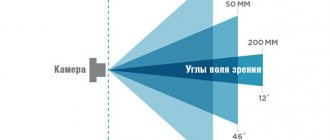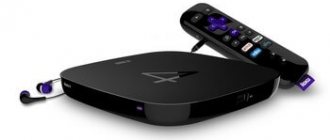The variety of TVs in recent years is simply amazing. One of the most important characteristics of monitors is their brightness and color rendition. So, in addition to the familiar abbreviation LED, today OLED and QLED are also presented. How are these concepts different?
In order to more accurately understand the difference, it is important to study in more detail the characteristics of each of them. You will need to highlight the advantages and disadvantages of monitors, as well as how differences between them can affect the quality of the transmitted image.
LED LCD what is it?
These types of monitors are quite common. They have a number of characteristics, and also have a variety of models, distinguished by monitor size. To understand their nuances, you should find out what the term LED LCD itself means.
So, LCD is understood as a panel that includes several sheets of a special material, between which a special solution is placed.
LED is one of the backlights for LCD panels, which is based on the activity of LEDs.
In other words, LED LCD is a liquid crystal monitor that has LED backlighting. As a result, the picture on such a screen is brighter and more saturated in quality.
Black Level – Winner: OLED
A display's ability to perfectly reproduce deep blacks is the most important factor in ensuring excellent image quality. The darker the black color on the screen, the higher the contrast of the image and the richer the color gamut (among other parameters), which in turn makes the image more realistic and mesmerizing. If we talk about comparing the quality of black color display, then OLED technology is the undisputed champion. An LED display is a display that uses LED backlighting on a liquid crystal panel. Even with modern dimming technologies that darken LEDs that don't need to shine at full power, LED TVs aren't up to the task of producing deep blacks. In addition, they suffer from some involuntary glowing around the edges. OLED TVs are not affected by any of the above problems. If no electricity is supplied to the OLED pixel, it emits absolutely no glow and therefore remains black, like anthracite.
OLED
This panel concentrates a large number of organic LEDs. Each cell of the panel has its own special light source, and their brightness is adjusted individually. As a result, there is no need to illuminate the panel. Therefore, if we talk about local dimming, which is available in LED LCD, then here you can observe local backlighting. With its help, it is easier and more effective to control the black level, as well as contrast.
4K OLED displays were first released in 2014 by LG. Years later, the presented panel could be found in the Panasonic, Sony, and Samsung brands.
The key differences between the panel include the following:
- Possessing high contrast;
- More uniform illumination. In case you want to darken the screen completely black, you will not find any white areas.
- Wide viewing angle.
- Short service life. It mainly varies around 6000 – 7000 hours. In other words, you will use this TV for about 2-4 years with moderate viewing.
- Subject to good maintainability.
Difference between LED and OLED
LED and OLED are different types of light emitting diodes, the former are made of inorganic semiconductors while OLEDs are made of organic materials.
OLEDs are an offshoot of existing traditional LED technology. LEDs are semiconductor light sources that function through electroluminescence, meaning they produce photons (light) by forcing electrons into small electron holes on the emissive layer of the device. Electricity comes in and light comes out thanks to the semiconductor material.
OLED technology, first successfully implemented in 1987 by Kodak researchers, uses the same idea as LED but smoothes it out. Instead of using individual LED bulbs, OLED uses a series of thin light-emitting films. This allows the OLED matrix to produce brighter light while consuming less power. And because these light-emitting films are made of hydrocarbon chains rather than semiconductors loaded with heavy metals, they are allowed to be called “organic.”
The LEDs in modern LED TVs are actually only used to provide a white backlight, which is then illuminated through a rapidly refreshing LCD shutter array that colors the light emitted. OLED technology works both as a light source and as a color matrix. And here are the benefits it offers.
Color and brightness
OLED TVs are leading here.
LED TVs using an LED backlight behind the LCD panel, even with advanced dimming technology that selectively dims the LEDs, can suffer from an effect called “light bleed,” where lighter areas of the screen create haze or blooming in adjacent dark areas.
Even with the newest LED models, these problems are inevitable, although it is important to note that in 2021 manufacturers have shown significant breakthroughs in LED technology.
OLED TVs do not suffer from the black level problems of traditional LED TVs. If the OLED pixel does not receive electricity, it does not produce any light and is therefore completely black. Because OLEDs have their own color filters built in, they can produce deeper blacks and a wider gamut range. The absence of an always-on backlight helps increase contrast (the difference between the brightest and darkest pixels on the screen).
It's important to note that all modern TVs - OLED, LED/LCD or otherwise - produce more than enough brightness. And if you're thinking about buying a TV, consider where the equipment will be used: in a dark, enclosed room, an OLED TV will perform better, but in a brighter environment, LED TVs will outshine their competitors.
Resolution and viewing angle
OLED TVs are also preferred in this category.
Due to the lack of a shutter array, OLED displays can have refresh rates orders of magnitude higher than LCD TVs. We're talking about a boost from 480Hz to 100,000Hz - theoretically, at least.
On top of that, OLEDs offer an impressively wide viewing angle—around 90 degrees off-center for many panels—without the loss of color and clarity seen with traditional LEDs. LED screens suffer from reduced picture quality if you sit too far to one side or if the TV is too high or too low relative to your eyes. OLED TVs do not have this dependence.
Response time and power consumption
Response time refers to the time it takes for each individual diode to change its status from On to Off. The faster the response time, the less motion blur and artifacts.
OLED, with its smaller diodes acting as the only pixels, easily leaves LED TVs behind when comparing models in terms of response time. The diodes in LED TVs are not only slower, but they are also located behind the LCD panel, where they illuminate specific clusters rather than individual pixels. This causes a slower change between the On and Off states. OLED currently offers the fastest response times of any TV technology in use today, making it the clear winner in this regard.
When comparing power consumption, an OLED display does not require the electronics and circuitry used to control the LED backlight and LCD shutter from the LED display, making OLEDs more efficient. LED screens produce black by simply closing the pixel shutter completely, while the backlight is still lit (in fact, it never turns off), but the light itself is blocked. Whereas OLED turns off pixels completely to produce black, saving power in the process.
Although, if you're browsing the web on your OLED TV, sites with a lot of white on the screen will cause your OLED to use more power than a comparable LED TV.
There's another strength of OLED panels: the elimination of backlights and grilles also means manufacturers can replace the heavier glass substrates often used in LED displays with lighter, stronger plastic substrates. And with the advent of 3D printing technologies, these light-producing OLED elements can have completely exotic surface shapes.
OLED films themselves are quite durable and can withstand a wider range of operating temperatures than conventional LEDs without failure. But as for 4K TV technology in OLED, it has not been very tested. This is a bit of a concern, especially when you remember that early plasma displays had a problem with screen burn-in.
4K LED TVs have LED backlighting around the edges (or a full array), they are reliable and have stood the test of time quite well. This technology can provide you with up to 60,000 hours of viewing time (if this value is divided into 4 hours of viewing time every day, it will be more than 40 years!).
Price
Currently, OLED sets cost nearly twice as much as LED TVs and nearly three times as much as conventional LCDs. But once 3D printing-based manufacturing capabilities are sufficiently expanded, the cost of manufacturing OLED panels should drop significantly and be comparable to its competitors.
Today, OLED TVs are the premium segment of TVs. The winner in this category is LED.
QLED
If you study this technology in detail, it differs in that the LEDs used are those that contain quantum dots. The term itself was developed by Samsung and is used as a corporate name for the latest monitors.
The essence of the work is that they took the main ordinary LED LCD display and placed a nano filter made of metal between it. With its help, it became possible to obtain high image brightness, as well as look at the screen with rich tones.
We have a winner! Wait... Is there a winner?
In terms of image quality, an OLED TV leaves absolutely no chance of winning over LED/LCD. Plasma is capable of the same thing, for that matter. However, if image quality is your main concern, you'll have to make a lot of compromises. You'll have to live with the 55-inch screen size limitation while your neighbors boast about their new 70-inch TV. You will have to come to terms with the fact that an OLED TV bought today for crazy money will cost much less in a few years. You will have to come to terms with the fact that you won't be able to hang your TV on the wall, while those people who grow up to buy their first OLED model in about two years will be able to become the owners of a much thinner TV that will simply still blend in with the interior of their living room. And finally, you will have to restrain your emotions, trying not to think about the fact that your TV may not last ten years. Thus, the main question arises: if money is not a problem for you, is it worth buying an OLED TV today, or is it better to wait a few years?
Author: Caleb Denison
Comparison of OLED, LED, QLED
And now, knowing the features and characteristics of each model, you can start comparing them. We will do this between LED and QLED from OLED.
Black noise level.
This characteristic is associated with the minimum glow of the monitor, while the level of white noise is at its maximum. The contrast value is usually considered as the ratio of black noise to white noise.
QLED. It features a VA panel but lacks local dimming features. As a result, contrast control is slightly lower than that of LED LCDs.
OLED. Although the entire image is not shown and cannot be completely darkened, the black level is absolute and the contrast is infinite.
LED LCD. It may show maximum contrast concentration values. True, its meaning is different and depends on the panel manufacturer.
OLED wins in this segment.
Response time
Objects moving across the screen will certainly leave traces. After all, the pixels that form the image try to dramatically change their shades. The shorter the response time, the smaller the footprint you get.
QLED. It is characterized by fairly fast switching (about 2 times), in comparison with the Samsung KS8000. The result is a cleaner image with less offset.
OLED. Due to the special nature of the light and shades from organic LEDs, the pixels are able to change color quite quickly, so the response time is minimal.
LED LCD. This value as a response time will depend on the TV model. If we consider a cheaper option, then there is a higher level of blur, in the more expensive segment it is less high.
OLED once again wins this category.
Viewing angle
QLED. Here we see an almost identical viewing angle to that of the Samsung KS8000. The only thing is that the breadth is not particularly rich, although the announcement said that it would be completely different.
OLED. Has a minimal viewing angle.
LED LCD. Not every monitor has the same viewing angle. True, some still have a good value in this category.
The category winner is OLED.
Volume of color
The indicator is distinguished by its novelty. Its value indicates how accurately the shade can be conveyed, which takes into account the concentration of the color gamut and brightness in three-dimensional space.
Please note that the color gamut allows you to characterize the largest number of shades that the monitor can display. Peak brightness represents the maximum brightness level of your screen. The wider the color gamut, the brighter the image you get. Therefore, the color volume is higher.
QLED. Such panels have multi-HDR. It is due to this that the brightness of color rendering is achieved in 5% color coverage. Due to the presence of a special certificate received from a well-known German company, the model with this panel has up to 100% accuracy in color reproduction. It is impossible to achieve such a result.
OLED. A large number of monitors have multi-HDR. Thanks to it, we get brighter and more realistic shades. As well as the depth of black, due to it the perception of brightness increases several times.
LED LCD. In such premium monitors, the manufacturer has introduced an HDR function. HDR delivers a rich color palette that reflects up to 95% of the entire color space. And also, with its help it is possible to obtain the most reliable color.
QLED wins this category.
What does OLED mean?
OLED LEDs are thin, flexible and small.
OLED TVs contain special elements in the matrix that do not need an additional light source - they generate it themselves. The key advantages of such screens: color rendition close to realistic, minimal power consumption and “deep” black color (a single pixel does not light up at all).
If you translate OLED from English, you get “organic emitting light-emitting diode”. To make such elements, organic compounds are made, and when a current passes through them, they light up.
Without going into details, the difference between LED and OLED TVs seems insignificant, but the LEDs used in the second technology are thin, flexible and so small that they can be used as individual pixels (more than a million organic diodes are “scattered” throughout the screen, which light up and go out on their own, independent of each other).
OLED devices have adjustable brightness for each pixel, which allows you to significantly increase the level of contrast and detail in the image.
The ability of the display to display truly “deep” black color is a significant advantage on which the quality of the picture depends. The final image displayed on the screen looks more contrasty and more realistic.
In OLED panels, an LCD screen is not placed above the array of organic diodes, which makes it possible to reduce their thickness. For example, the 4K OLED model LG G6 has a screen thickness of 2.57 mm.
Direct LED backlight
The principle of operation of a television receiver with an LCD screen and Direct LED technology is to install LEDs directly behind the back surface of the LCD matrix. This technology ensures uniform distribution of light flux and its uniformity over the entire surface of the screen. To increase uniformity, a light diffuser is placed between the LCD screen and the LEDs. Edge LED backlight
Edge LED backlighting technology is based on the edge placement of the LED block - most often on the left and right sides of the TV. A strip with LEDs of this type of backlight is fixed on the side surfaces of a matte diffuser, which ensures uniformity of the light background.
The end arrangement of LEDs in models with Edge LED technology reduces the overall thickness of the TV body, but places increased demands on the mechanical accuracy of the location of the LED blocks. If accuracy is violated, so-called flares appear on the TV screen - uneven luminescence in the form of light spots.
Edge LED
Edge LED backlighting in LCD TVs is the most used and cheapest technology for their production. It involves installing LEDs - semiconductor elements that emit photons of light when current passes through them - along the perimeter of the matrix or at its ends.
- the ability to make thin panels, which are becoming more and more popular, although they have no practical benefit, only aesthetics;
- increased brightness has a positive effect on TV viewing.
- the price of TV is higher due to the high cost of producing a reflective surface with a matte coating to evenly distribute reflected light over the entire area of the matrix to avoid the appearance of light spots;
- highlights are closer to the edges of the screen - the picture in the center will be a little darker, this is especially noticeable in dark frames
Many models use local dimming tape, which allows minimizing brightness differences over the entire area of the picture.
Features of OLED TVs
What is OLED? Organic light-emitting diode is the name of a new type of LED. The technology is based on the use of the conductive ability of certain organic polymers. Most often, OLED is used in the production of the latest generation of modern TVs.
OLED technology uses a film of organic light-emitting diodes to illuminate the screen. OLED lighting is formed from several layers of organic polymers that can emit light when an electric current is applied to them. The small sizes of individual connections make it possible to create pixel matrices based on them. Since every pixel emits light, there is no need for additional backlighting.
Leave a request and receive a 15% discount on your first repair!
Submit your application
Direct LED
The second type of backlight differs from the first in the geometry of the arrangement of semiconductor elements emitting visible light with given parameters, and in their number. And these indicators greatly influence the technical characteristics of the matrix.
- high level of contrast in dark and light scenes;
- a good reserve of brightness allows you to watch TV comfortably on a bright day;
- increased maintainability of panels;
- uniform distribution of light throughout the matrix eliminates the appearance of glare;
- Due to the direct nature of the radiation, energy consumption is reduced.
- high image output delay;
- You can't make an ultra-thin case.
An abbreviation for full-array local dimming, which means full-array direct illumination. This is the same Direct LED (we discussed what it is above), but in a new light that is beneficial for TV manufacturers and marketers.
The number of local zones can range from several dozen to 320 or more. Some flagship models support turning off individual light-emitting elements to maximize picture quality. Used only in expensive TV receivers with 4K resolution.
Which TV backlight is better depends on the preferences and thickness of the consumer’s wallet. If you don’t need a thin panel with glare (you definitely need to evaluate the image in the store), you should choose Direct LED. When buying an expensive 4K TV, if you don’t mind the money, you can get a flagship model with FALD backlighting.
«>











